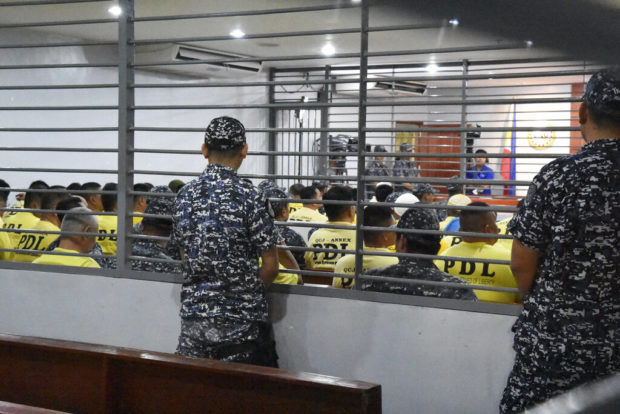
From the Website of INQUIRER
Andal Ampatuan Jr., kin guilty for Maguindanao massacre of 57 people
MANILA, Philippines–After almost 10 years of trial, the Maguindanao massacre case verdict has been laid down and the Quezon City Regional Trial Court has found Datu Andal Ampatuan Jr., a former Maguindanao town mayor, his siblings and several others guilty for the murder of 57 people.
Aside from Ampatuan Jr., also found guilty are his brothers former Autonomous Region in Muslim Mindanao (ARMM) governor Datu Zaldy “Puti” U. Ampatuan and Datu Anwar Ampatuan Sr.
The court also found guilty Datu Anwar Sajid “Datu Ulo” Ampatuan and Datu Anwar “Datu Ipi” Ampatuan Jr. guilty.
Also convicted are the following:
- Inspector Saudi Mokamad
- Patrolman Jonathan Engid
- Abedin Alamada a.ka. Kumander Bedi
- Talembo “Tammy” Masukat a.k.a Talembo Kahar Abdulrakman
- Theng P. Sali a.k.a. Abdullah hamid Abdulkahar
- Manny Ampatuan,
- Nasser Esmael a.k.a. Nasrudin Esmael
- Police Major Sukarno Dicay
- Supterintendent Abusama Mundas Maguid
- Superintendent Bahnarin Kamaong
- Tato Tampogao,
- Mohades Ampatuan
- Mohamad To Datumanong a.k.a. Nicomedes Amad Tolentino
- Misuari Ampatuan
- Taya Bangkulat
- Salik Bangkulat,
- Thong Guiamano a.k.a. Ibrahim Kamal Tatak,
- Sonny K. Pindi a.k.a. Joven Salazar Piang
- Armando Ambalgan a.k.a. Jamil Bulatukan Kayansang/Bolatokan Omar
- Kudza Masukat Uguia a.k.a. datu Teng/Mustapha Ibrahim,
- Edres Kasan a.k.a. Edres Gogo Alip,
- Zacaria P. Akin
- Samaon Andatuan
They are all meted with the penalty of reclusion perpetua or up to 40 years imprisonment without the benefit of parole.
Applause followed the reading of the verdict in a packed and heavily secured courtroom, where some relatives of the victims and their lawyers were present.
The case involves more than 100 detained suspects led by members of the Ampatuan family and many police officers and government militiamen. It had dragged on in a high-profile test of the Southeast Asian nation’s notoriously clogged and vulnerable judicial system. About 80 suspects remain at large.
Jail guards stand next to a crowd of accused waiting the promulgation at the trial venue inside a prison facility at Camp Bagong Diwa in Taguig City. SC-PIO via AP
While the mass killing has largely unraveled as an offshoot of a violent electoral rivalry common in many rural areas, it has also showcased the threats faced by journalists in the Philippines. Thirty-two of those gunned down were local reporters and media workers in the worst single attack on journalists in the world.
“If I have the power to kill them all in a blink of an eye, I would have done it. But I realized in the end that I’m not a demon like them,” said Mary Grace Morales. Her husband, a reporter of a local provincial newspaper, and her elder sister, the paper’s publisher, were among those killed mostly in a blaze of automatic rifle fire as they begged for their lives.
“What I can accept is a 100% conviction of all the accused,” Morales told The Associated Press in an interview on the eve of the court verdict. “An acquittal of even one of the principal suspects will be unacceptable.”
Morales, her daughter and a handful of close relatives of the slain journalists were flown to Manila with the help of a media watchdog, the National Union of Journalists of the Philippines, to hear the judgement.
In a candlelit protest Wednesday night in a park, they held portraits of their slain relatives and joined reporters in calling for justice, the defense of press freedom and the conviction of the Ampatuan family members, led by Ampatuan Jr., who is also known by his nickname Unsay.
Then a town mayor, Ampatuan Jr. allegedly led nearly 200 armed followers who blocked a seven-vehicle convoy carrying the wife, sisters and other relatives and lawyers of Esmael Mangudadatu, a politician who decided to run for governor of Maguindanao province. He challenged the powerful Ampatuan clan, who held sway over almost every aspect of life in the impoverished region wrecked by a Muslim insurgency, witnesses testified.
The journalists joined the convoy on Nov. 23, 2009, to cover the filing of candidacy of Mangudadatu in an election office in Maguindanao’s capital. Mangudadatu, now a legislator in the House of Representatives, was not in the convoy for security reasons.
The gunmen commandeered the convoy, including the passengers of two unsuspecting cars that got stuck in the traffic, to a nearby hilltop, where a waiting backhoe had dug huge pits to be used in burying the victims and their vehicles.
Ampatuan Jr. and his followers allegedly opened fire on the victims at close range and hurriedly escaped after sensing that army troops were approaching. The badly mutilated bodies were found inside the vans, sprawled on the ground or buried in the pits with some of the vehicles, in a gruesome scene that drew international outrage and shocked many even in a country long used to political violence.
Ampatuan Jr. along with his father and other siblings and relatives were placed under arrest after negotiations with officials of then-President Gloria Macapagal Arroyo. The Ampatuan clan, backed by government firepower and armed militias, had helped quell Muslim guerrillas in the region.
Ampatuan Jr.’s father died in detention in 2015. The family patriarch allegedly approved the plot over family dinner, according to the testimony of one witness.
The Ampatuans have denied the allegations and are expected to appeal. There is no death penalty in the Philippines.
Human Rights Watch called on the government to bolster efforts to apprehend about 80 suspects who remain at large, warning that they pose a threat to witnesses, including families of the victims.
At least three witnesses against the Ampatuans have been killed over the years, according to Nena Santos, a lawyer for Mangudadatu and families of several other victims. She said she had been threatened with death multiple times and offered a huge amount of money to withdraw from the case.
Gloria Teodoro, whose journalist husband was among the victims, said the government should work to eradicate the lethal mix of problems that allowed the massacre to happen, including a large number of high-powered firearms in the hands of many politicians and clans and a long-entrenched culture of impunity.
“If justice is not attained, if they played around with this case, we will see more of these. Maybe not in such a gruesome scale but it will happen again,” she said.
OTHER HUMAN RIGHTS PROMOTIONS WEBSITES
----------------------------------------------------------------------------------------------
PROTECTION AND PROMOTION OF HUMAN RIGHTS
---------------------------------------------------------------------------------------------
--------------------------------------------------
------------------------------------------
--------------------------






































